Top Crystal Identification Apps Reviewed
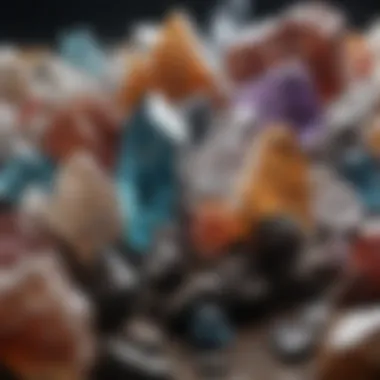
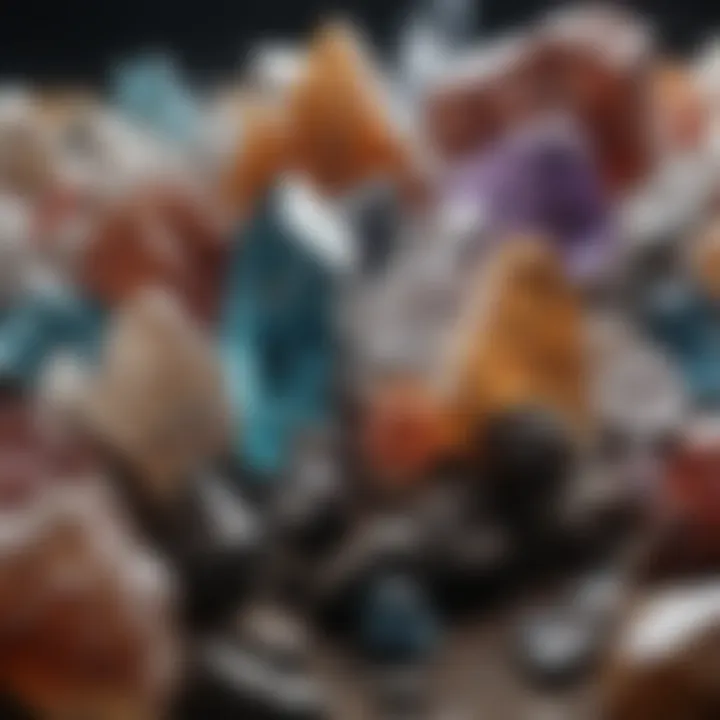
Intro
The field of geology has seen a surge of interest recently. Many individuals are exploring crystals not just as decorative items but for their potential educational value. The rise of technology complements this exploration, making it easier than ever to identify and learn about different crystals. Crystal identification applications fulfill this need by providing users with tools and methods that enhance their understanding and appreciation of these geological artifacts.
In this article, we will examine various crystal identification apps, focusing on their key features, benefits, and any potential limitations. This guide is intended for everyone, from novices discovering new interests to experienced collectors seeking to deepen their knowledge.
Featured Collectible of the Month
Overview
Each month, a notable crystal can be highlighted. For example, a popular choice might be Amethyst, prized for its stunning purple hues and accessibility. This crystal is not only beautiful but also rich in history, making it an excellent candidate for this section.
Historical Significance
Amethyst has been revered throughout history. Ancient Greeks believed it could prevent intoxication, while in the Middle Ages, it was considered a stone of royalty. Its captivating color has inspired many cultures and continues to be a sought-after crystal by collectors today.
Identification Techniques
Understanding how to identify crystals effectively requires knowledge of specific characteristics.
Visual Characteristics
When identifying crystals, certain visual traits are essential to recognize:
- Color: The first thing noticed in a crystal's appearance.
- Clarity: This speaks to how transparent a crystal is.
- Luster: Refers to how light interacts with the surface of the crystal.
- Shape and Structure: The geometric form can indicate how a crystal will appear in its natural state.
Resources for Identification
Apart from using crystal identification apps, additional resources can greatly assist in verifying crystal types:
- Books: Reference guides specific to crystals can provide detailed descriptions and images.
- Online Forums: Platforms like Reddit and Facebook host communities interested in crystals, offering opportunities to engage with other collectors.
- Websites: Educational sites such as Wikipedia and Britannica can be valuable for more extensive research on individual crystals and their properties.
"Crystals offer not just beauty but a gateway to understanding our planet's geological history and processes."
With advancements in technology, crystal identification apps stand out as essential tools for modern collectors. They bridge the gap between curiosity and knowledge, empowering users to appreciate the complexity of the materials they collect.
Preamble to Crystal Identification
Crystal identification plays a crucial role in the fields of geology, mineralogy, and paleontology. Enthusiasts and collectors often seek ways to accurately identify the minerals and crystals within their collections. Accurate identification not only enhances the understanding of specimen's origins but also allows collectors to appreciate the unique properties and classifications of their finds. In recent years, there has been a growing interest in this area, largely fueled by advancements in technology and accessibility of information.
When individuals can identify crystals properly, they can engage more meaningfully with their hobby. It elevates their collecting experience, enabling them to connect more deeply with the geological history of their specimens. Furthermore, accurate identification can serve practical purposes. For instance, certain crystals possess specific properties that can have implications in fields such as healing, construction, and jewelry. Thus, mastering crystal identification becomes an essential skill for both amateur and experienced collectors.
With technology evolving, the ways in which enthusiasts can identify and learn about crystals have expanded impressively. This article aims to explore various crystal identification apps that harness modern technology to aid users in recognizing and understanding these fascinating geological specimens, ultimately enriching the experience of collecting and studying crystals.
The Importance of Accurate Identification
Accurate identification of crystals is not merely an academic pursuit; it holds significant value for both avid collectors and professionals alike. Firstly, correctly recognizing a crystal leads to proper classification. This classification can unlock insights into the mineral's formation process, its geographical origins, and its potential uses or benefits. Even the most seasoned collector can benefit from this knowledge, as it provides context that enhances the overall appreciation of the specimen. Misidentification can lead to confusion and frustration, as collectors may misjudge the value or significance of their crystals.
The growing popularity of crystal healing and alternative therapies further underscores the need for precision in identification. Many people purchase crystals based on their purported properties. Therefore, knowing the specific type of crystal is vital to harnessing its potential benefits effectively. Misidentifying a crystal could result in disappointment when the expected benefits do not manifest, which emphasizes the need for reliable tools and resources for accurate identification.
How Technology is Transforming Crystal Study
Technology's impact on crystal study is profound and multifaceted. With the advent of smartphones and specific applications, the tools for crystal identification have become more accessible to the general public. Users no longer need to rely solely on books or expert consultation for identification; instead, they can simply use their devices to get immediate, accurate results.
Crystal identification apps typically leverage databases that contain detailed information about numerous minerals and crystals. Many of these apps include features such as image recognition technology, which allows users to take a photograph of their specimen. The app analyzes the image and provides potential matches, along with essential information such as hardness, locations, and uses. This level of accessibility encourages more people to engage with geology and crystal studies.
Moreover, technology fosters community engagement. Various apps incorporate social features that allow users to share their findings and experiences with others. This sharing of knowledge can lead to enriched learning opportunities and foster connections among enthusiasts. Overall, technology is reshaping the landscape of crystal identification, making it a more interactive and user-friendly experience.
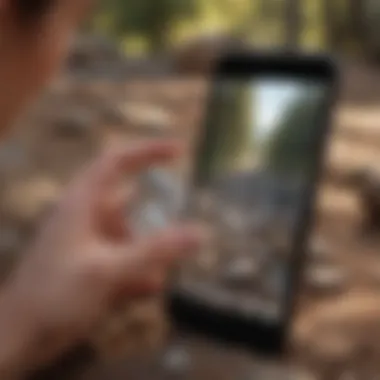
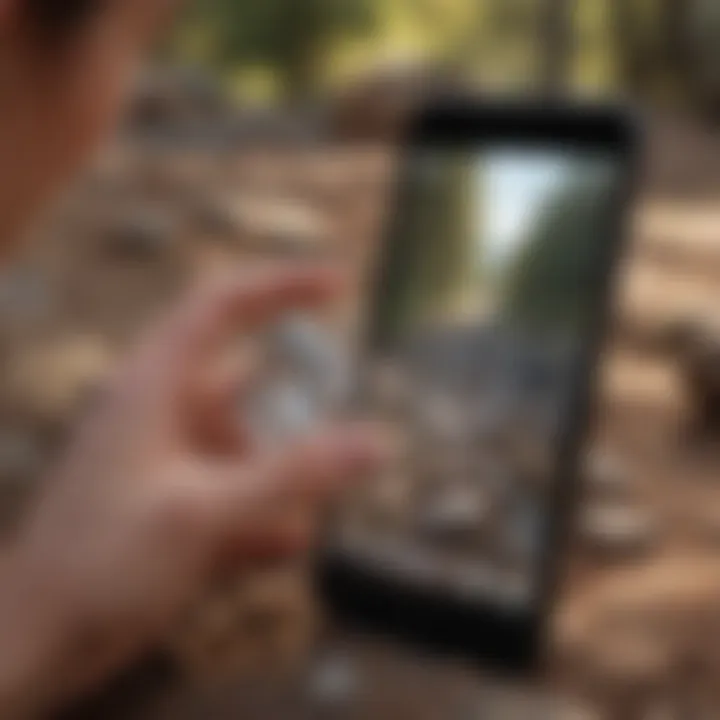
Characteristics of Effective Crystal Identification Apps
Understanding the characteristics of effective crystal identification apps is crucial for both beginners and seasoned collectors. These apps are not just tools but are pivotal in enhancing the way enthusiasts engage with their collections. Examining specific elements like user interface, database size, and integration with other tools can significantly affect how one identifies and learns about crystals.
User Interface and Experience
A well-designed user interface is essential for any app to be effective in crystal identification. The layout should be intuitive, enabling users to navigate effortlessly between different sections of the app. When users can quickly locate features, they are more likely to use the app regularly.
For example, the inclusion of clearly labeled menus and an organized categorization of crystals can reduce the time it takes to find specific information. Visual elements should not be overly crowded; each crystal's picture needs to be sufficiently clear and prominent. Furthermore, a mobile-friendly design that adapts well to various screen sizes ensures that users have a pleasant experience on any device.
User experience also extends beyond the interface. Providing detailed descriptions, educational materials, and identification quizzes can enrich the learning journey. Apps that create a community experience, where users can share finds or seek help, can deepen engagement.
Database Size and Accuracy
The size and accuracy of a crystal identification app's database are critical components. An extensive database with a wide range of crystal types allows users to identify various specimens more effectively. However, quantity alone is insufficient; the accuracy of the information is paramount.
Users should have access to scientifically accurate descriptions, properties, and photographs of the crystals. Misidentifying a crystal can lead to misunderstandings about its properties and uses. It is beneficial for apps to regularly update their databases as new discoveries are made in the field of geology. A good crystal identification app might also include user-generated content, allowing for a dynamic and evolving database.
Additionally, the use of advanced algorithms and machine learning can enhance identification precision. Some apps might leverage image recognition technology, allowing users to take a photo of a crystal for immediate identification. This technology can improve learning by providing immediate feedback and validation.
Integration with Other Tools
Integration with other tools and platforms can substantially enhance the user experience in crystal identification apps. This could involve linking the app to educational resources, forums, or databases that offer further information. For instance, an app that connects to geological databases or scientific journals would provide users access to a wider range of knowledge and updated research.
Moreover, integration with social media can facilitate sharing of discoveries and learning from others’ experiences. Many users appreciate the ability to post their finds on platforms like Reddit or Facebook, seeking advice or insights from fellow enthusiasts.
Tools that allow users to keep track of their collections and organize them efficiently can also add value. This could be achieved through features such as customizable storage solutions, tagging systems, or tracking historical data on the user’s crystal finds.
"The combination of a strong database, user-friendly design, and integration with educational resources creates a valuable tool for both novice and expert collectors."
Overall, the characteristics of effective crystal identification apps can significantly enhance the experience of collecting. They should be considered as more than just simple identification aids; they help shape an informed and engaged community of crystal enthusiasts.
Popular Crystal Identification Apps
The advent of technology has significantly influenced the field of geology. Crystal identification apps play a central role in bridging the gap between enthusiast and expert. These mobile tools have made it more accessible for hobbyists to engage with their passion, enabling them to identify and learn about different crystals with ease. As the demand for such applications grows, it is crucial to explore the variety available, understanding their unique offerings and limitations.
By elaborate on popular apps used for crystal identification, users can make informed decisions on which tools best fit their needs. Each application serves not only to identify crystals but also to provide educational resources and community support. This collective effect benefits both novice collectors and seasoned geologists alike.
App One: Features and Benefits
Mineral Identifier is one of the leading crystal identification apps. One key feature is its comprehensive database, which allows users to look up a wide array of minerals and crystals. Users can take pictures of a crystal and the app uses image recognition to provide information. This functionality is particularly useful for those without an extensive background in geology.
The app also includes educational resources, featuring articles and videos that deepen users’ understanding of crystallography. Users can save their findings, which helps in keeping track of their collections. Additionally, the option to connect with a community of enthusiasts fosters knowledge sharing and collaboration.
App Two: Features and Benefits
Rock Identifier offers a distinct approach by focusing on user interactivity. Users can join forums, share photos, and ask questions related to their finds. The app includes detailed information about each crystal's properties, such as hardness, streak, and luster. This assists users in not only identifying but also assessing the quality of their specimens.
When it comes to usability, the app offers an intuitive interface, enhancing user experience. The step-by-step guides help users understand how to examine crystals accurately. This interactive aspect engages users and encourages ongoing exploration of their interests in minerals and crystals.
App Three: Features and Benefits
Gem Finder distinguishes itself with its specialized focus on gems and semi-precious stones. The app caters to users looking for detailed insights into the gemstone market. Besides identification features, it provides current prices and trends for various gemstones, making it an essential tool for those who may also consider trading their finds.
Another attractive feature of Gem Finder is its augmented reality (AR) feature, which allows users to visualize gems in a realistic setting. This can be particularly enticing for collectors interested in display arrangements. Like its counterparts, this app comes with a wealth of educational material, enhancing the user’s overall experience.
Comparative Analysis of Leading Apps
Performing a comparative analysis of leading crystal identification apps is crucial for enthusiasts and collectors alike. This analysis provides clarity on what features set these tools apart, helping users choose the most suitable one for their needs. Different apps offer varying levels of functionality, user experience, and accuracy. Understanding these differences allows users to make informed choices and effectively utilize these tools.
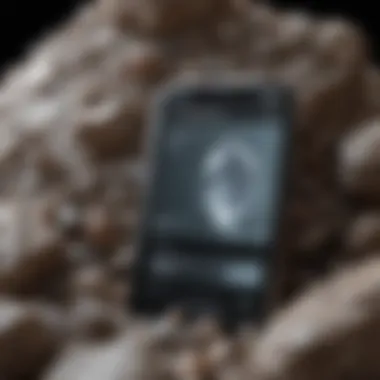
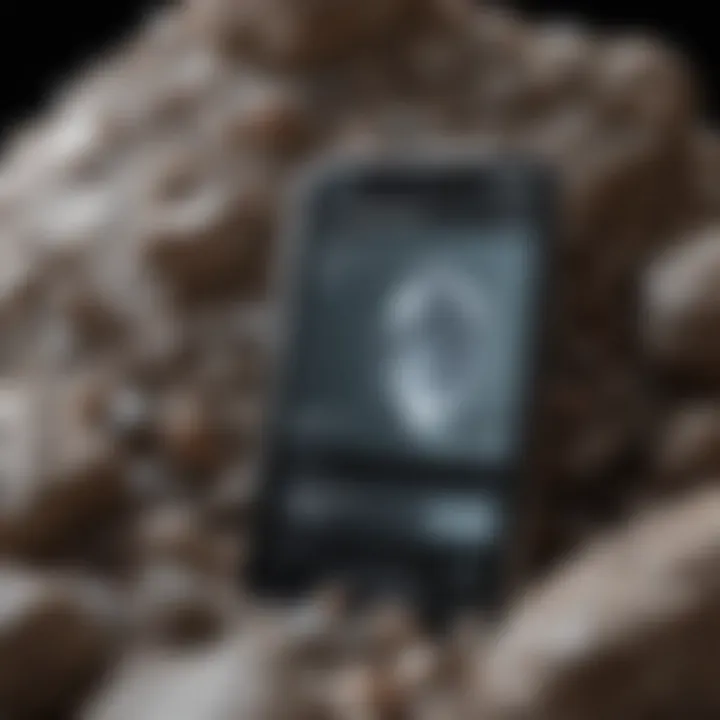
Strengths and Weaknesses
Every application designed for crystal identification has its own unique strengths and limitations. Evaluating these can guide users toward the right tool.
- Strengths
- Weaknesses
- User-Friendly Interface: Many apps are designed with simplicity in mind, allowing users to easily navigate through options and quickly find crystal information. Applications like Rock Identifier excel in this aspect, offering a clean layout that reduces the learning curve.
- Extensive Databases: Apps such as Minerals provide comprehensive databases that include detailed information on various crystals, making identification easier and more precise.
- Community Support: Some applications feature community forums or social sharing options, like Crystals 4 You. This allows users to share findings and ask questions, further enhancing the learning experience.
- Limited Accuracy: While many apps boast large databases, not all entries are verified. For instance, some user-generated entries in GemMatch may lead to misidentification.
- Cost: Certain apps, despite their benefits, come with subscription fees or in-app purchases. Stone Identifier requires payment to access advanced features which might deter novice users.
- Hardware Dependence: Several applications perform poorly on older devices, affecting user experience. If the app is not optimized for a user's device, it can slow down the identification process.
"Choosing the right crystal identification app is not just about the features, but also about ensuring that it aligns with your personal collecting style and needs."
Cost Considerations
The financial aspect of crystal identification apps cannot be ignored. Apps can be categorized into three main types based on cost: free, freemium, and premium.
- Free Apps: These are often limited in features but can be a good starting point for beginners. Apps like Crystal Collector allow users to test functionalities without any risk.
- Freemium Apps: This category offers a mix, where basic identification is free, but advanced features come with a cost. For example, Rock Guide provides essential tools but charges for additional crystal databases and features.
- Premium Apps: Apps such as Crystal Encyclopedia often require purchase upfront but may provide extensive resources suitable for serious collectors. Users must weigh the upfront cost against long-term benefits.
User Perspectives on Crystal Identification Apps
User perspectives play a crucial role in understanding the effectiveness and relevance of crystal identification apps. As users interact with these tools, they form insights that can highlight how well these apps meet their needs. Focusing on user experiences provides valuable information regarding their functionality, usability, and overall satisfaction. Such insights are essential for potential users, particularly for rock and fossil collectors who look for reliable solutions to enhance their understanding of crystals.
By evaluating testimonials and acknowledging common challenges, one gains a comprehensive view of how these apps perform in real-world scenarios. User feedback can point out features that are especially appreciated, as well as those that fall short. Ultimately, this section will explore both positive and negative aspects gathered directly from the app users, contributing to a balanced understanding of crystal identification technology.
User Testimonials and Experiences
User testimonials offer critical insights into how crystal identification apps are utilized in practice. Many collectors share their experiences, often detailing the initial impressions they had upon using the app. For instance, some users may report a user-friendly interface that made navigation straightforward. This ease of use is often highlighted as a significant advantage, especially for beginners who may feel overwhelmed by taking up a new hobby.
Moreover, users might express appreciation for the accuracy of crystal identification. Several collectors mention that the apps helped them identify specimens that stumped them even after consulting books or online resources. These positive experiences not only validate the apps' claims but also encourage further exploration of the geological world.
"Thanks to the app, I identified several gemstones from my collection that were previously unknown to me. It expanded my understanding significantly."
In contrast, some testimonials may reveal dissatisfaction with certain apps. Users could mention issues such as outdated databases or lack of information on specific crystals. Feedback regarding slow scanning features or limitations in image recognition is also discussed. Addressing these concerns can aid developers in improving their applications, ensuring they better meet user expectations.
Common Challenges Faced by Users
While crystal identification apps bring many benefits, users often encounter challenges as well. Common issues include technical limitations or insufficient databases. Some users report difficulties with image recognition, especially in cases where lighting conditions are not ideal. This can lead to inaccurate identifications, ultimately frustrating users who rely on the apps for learning.
Another prevalent challenge is found in the disparity between app capabilities and user expertise. Novices might struggle with understanding the comprehensive information provided by the apps, which can be overwhelming. Additionally, while many apps offer an extensive list of features, some users might not fully utilize them due to a lack of guidance or tutorials.
Lastly, users have pointed out that keeping the app updated plays a significant role in its effectiveness. Some may experience discrepancies in the information available, which can stem from infrequent updates. As the geology field progresses, failing to incorporate new findings can hinder user experience.
By recognizing these challenges, both developers and users can take meaningful steps to improve the interaction with crystal identification apps. Identifying and addressing these pain points can lead to more satisfactory outcomes, fostering a better understanding of crystals for all enthusiasts.
Future Trends in Crystal Identification Technology
The realm of crystal identification is on the brink of transformative changes. As technology continues to evolve, new trends emerge that promise to enhance the efficiency and accuracy of identifying crystals. Understanding these future trends is crucial for collectors and enthusiasts who wish to stay ahead in their knowledge and practice.
These advancements not only aim to improve user experience but also integrate deeper science into the identification process. By exploring these emerging trends, users can harness the full potential of crystal identification applications, making their collecting journey more rewarding.
Emerging Technologies on the Horizon
Several emerging technologies show great potential for revolutionizing crystal identification. Machine learning and artificial intelligence are at the forefront. These technologies can analyze vast amounts of data, enabling apps to provide more accurate identifications and recommendations for collectors. Through sophisticated algorithms, the apps can learn from user input and improve identifications over time.
Additionally, sensor technology is evolving rapidly. New sensors can measure light refraction and other physical properties of crystals. Integrating these sensors into apps can lead to a more interactive experience for users. This type of data collection could yield insights that are impossible to achieve with current methods.
Other technologies include enhanced imaging techniques. High-resolution imaging can better capture the details of crystal structures. Improvements in smartphone cameras also mean that users can utilize these features to take clearer pictures to upload for identification. As these technologies develop, crystal identification will become more precise and user-friendly.
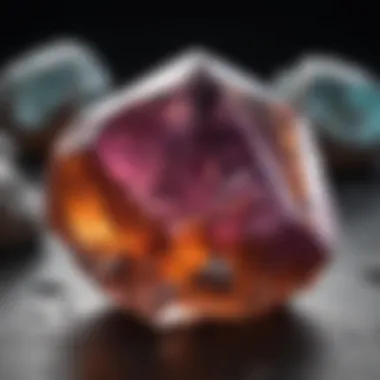
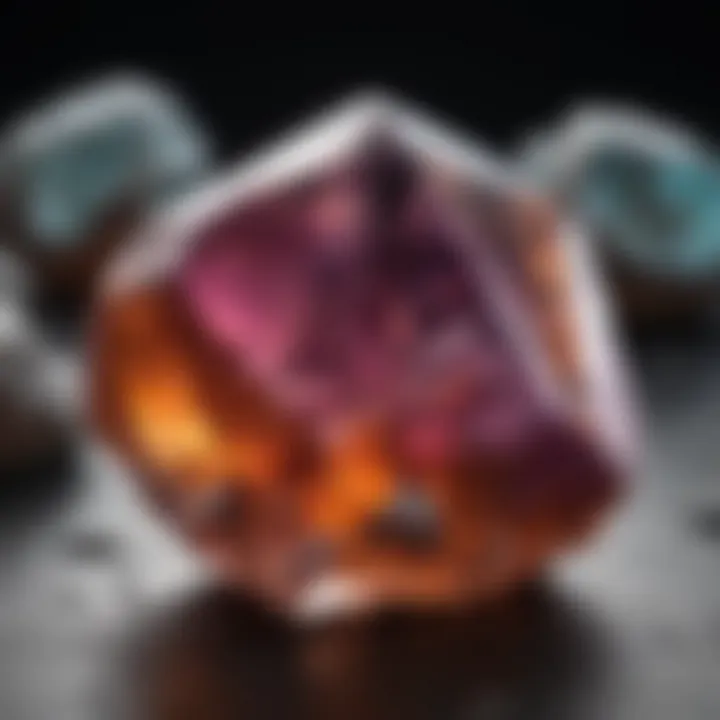
Potential for Augmented Reality
Augmented reality (AR) holds significant promise for the future of crystal identification. It offers an immersive experience that could drastically change how collectors interact with their crystals. Through AR, users might view the crystal's properties overlaid with information displayed right on their device screens.
Imagine pointing a smartphone at a crystal and instantly receiving details about its name, history, and uses. This could make the learning process more engaging and informative. AR could also facilitate virtual comparisons between crystals, making it easier to identify and categorize different specimens without needing to refer to physical guides.
Moreover, the potential for community interaction through augmented reality is vast. Collectors can share their findings in real-time, allowing for collaborative identification efforts. Such capabilities can increase the depth of knowledge among users while offering a social aspect to crystal identification.
"As technology advances, the possibilities in crystal identification are boundless, paving the way for a more informed and connected community of enthusiasts."
Tips for Utilizing Crystal Identification Apps Effectively
Utilizing crystal identification apps can significantly enhance your experience as a rock and fossil collector. While these apps provide access to extensive databases and visualization tools, understanding how to effectively integrate them into your collection practices is essential. This section outlines practical tips that can elevate your journey in crystal study.
Integrating Apps into Collecting Routines
Integrating apps into your collecting routine involves making the best use of the features offered. Start by ensuring your app is updated with the latest data. Many apps continuously expand their crystal databases, adding new species and updated information about existing ones.
Another effective strategy is to use the app directly in the field. When you encounter a new specimen, take a moment to identify it using your app. Use features such as photo capture, visual recognition, and detailed descriptions to compare and confirm your findings. Engaging with the app in real time can also enhance your understanding and retention of information about various crystals.
Additionally, consider sharing your findings on platforms such as Reddit or Facebook groups dedicated to crystal collecting. This not only promotes community engagement but also invites feedback from other collectors, potentially leading to more accurate identifications.
Keeping Records of Identified Crystals
Maintaining meticulous records of the crystals you identify is a cornerstone of serious collecting. Most crystal identification apps contain features that allow you to document your findings easily.
Here are some recommendations for effective record-keeping:
- Use the app’s database: Track every identified crystal within the app. This can help maintain a comprehensive catalog.
- Photograph specimens: Capture images of each crystal while noting their condition and characteristics. Visual records are invaluable for future references.
- Annotate your entries: Include details such as geographic location, date of collection, and any personal notes about the specimen.
These records contribute not only to your personal knowledge but can also serve as a valuable resource for others in the community.
"Documentation is key for building a reputable collection and ensuring the knowledge of each specimen is passed down."
In summary, effectively utilizing crystal identification apps covers both integrating them into your collecting routines and keeping detailed records. By following these tips, you can enhance your understanding of crystals while contributing meaningfully to the wider collecting community.
Culmination
In summarizing the exploration of crystal identification apps, it is vital to recognize their significance for both novices and seasoned collectors. These applications provide a bridge between casual interest and deeper scientific inquiry. As technology evolves, the tools available for identifying and understanding crystals have become more sophisticated and accessible.
The key elements discussed throughout this article highlight the robustness of features that such applications offer. From user-friendly interfaces to expansive databases, the identification process is streamlined and made more accurate. Additionally, the integration capabilities with other tools amplify their utility, allowing users to not only identify but also document their findings.
The benefits of utilizing crystal identification apps are manifold. They maximize the learning experience, saving time during field studies. Furthermore, the varied user feedback underscores the adaptability of these apps in real-world scenarios, addressing many challenges faced by crystal enthusiasts. With the right app, users can transform their interactions with geology from mere collection to a profound engagement with the science behind these wonders.
As crystal identification technology progresses, it is crucial to consider how these tools can enhance understanding further. The integration of augmented reality, for example, can redefine how collectors interact with their specimens. Thus, readers are encouraged to actively engage with these applications and stay informed about emerging trends.
Summarizing Key Takeaways
Reflecting on the key takeaways from this article:
- Identification Accuracy: Effective apps provide reliable results that can lead to enhanced learning.
- User Experience: A well-designed interface significantly influences usability.
- Database Quality: The size and accuracy of the database directly affect the app’s performance.
- Integration Options: The ability to work with other tools improves overall functionality.
- User Insights: Testimonials provide a realistic perspective on app performance.
The facts above are essential for anyone looking to refine their crystal identification skills.
Encouraging Continued Exploration
The world of crystal identification through apps is vast, and the potential for growth in this field is promising. Continuous exploration is essential to maximize the benefits of these tools. Users are encouraged to delve deeper into their specific interests within geology.
Practical steps include:
- Experimenting with Various Apps: No single app is perfect. Trying different options can reveal unique features suited to individual needs.
- Participating in Online Communities: Engaging in forums on platforms like Reddit can provide valuable insights and user experiences.
- Staying Updated on Trends: Following developments in technology can help enthusiasts remain at the cutting edge of crystal identification.
"The pursuit of understanding crystals is a blend of art and science, facilitated by the ever-evolving tools at our disposal."
By actively participating in this ongoing journey, users not only enhance their knowledge but contribute to a broader appreciation of geology as a whole. Embrace the journey of exploration; every crystal tells a story waiting to be discovered.



